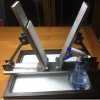How do you maintain an edge on super steel knives? In cases where you are not reprofiling or fixing edge damage, but simply maintaining an edge that has light to moderate wear.
For this thread, define 'super steel' loosely as modern PM steels that have high vanadium carbide content. Popular suspects: S30v, S35vn, S90v, S110v, Elmax, M390, 20CV, CPM 3V, and similar.
Interested to hear:
What I've been trying:
For this thread, define 'super steel' loosely as modern PM steels that have high vanadium carbide content. Popular suspects: S30v, S35vn, S90v, S110v, Elmax, M390, 20CV, CPM 3V, and similar.
Interested to hear:
- What method you use, and why. Stropping on X, edge-leading strokes on a high-grit stone, etc.
- What type of abrasives you use, and why. I've heard all kinds of responses here in the forum on this. Everything from plain strop/no compound (what material?), strop with compound (diamond, cbn, ???), fine ceramics (mildly controversial, but a number of accomplished sharpeners here do this), belt sander, or using coarse, fine, or high-grit stones.
What I've been trying:
- A few light edge-leading strokes on DMT fine diamond. Finally found a great use for my DMT fine plate: maintenance of super steels! It's just right, fine enough to not remove too much metal, but still coarse enough to not destroy my coarse scratch pattern that I normally sharpen with. Also tried DMT EF, since it removes less metal, but didn't like how much this overground the coarse scratch pattern and reduced slicing aggression. Assume the same logic would apply to DMT EEF, but maybe I'm missing something.
- A few stropping passes on wood strop with CBN 1 micron compound to remove any fine burr. Works but is a bit slow, I have some 4 micron CBN to try next.



